
2019 Junior Fellow Challenge
MR from the Global Perspective: The Underrepresented Part of the MR Spectrum
Indian MRI Challenge:
Accessible Stroke MRI
Dr. Sairam Geethanath1-2
1 Medical Imaging Research Center, Dayananda Sagar Institutions, Bangalore, India
2 Columbia University Magnetic Resonance Research Center, Columbia University in the City of New York, USA
CLOSED
Idea Submission Deadline: 30 January 2019, 23:59 EST
Stroke is the fourth major cause of deaths in India (1). The cumulative incidence of stroke ranged from 105 to 152/100,000 persons per year in various parts of India over the last two decades (2). Stroke occurs due to the lack of blood supply to the brain cells, resulting in subsequent irreversible neuronal dysfunction. Stroke is classified as hemorrhagic and ischemic stroke. Hemorrhagic stroke is caused by a bleeding which can occur in the brain, while ischemic stroke is caused by the blockage of cerebral arteries and is more common than hemorrhagic stroke. Stroke imaging is critical for diagnosis and/or prognosis of the disease. In particular, neuro-imaging is employed toward: (i) differentiating between hemorrhagic and ischemic stroke; (ii) localizing and assessing the intravascular clot; (iii) delineating ischemic core and ischemic penumbra; (iv) aiding in investigating the cause for stroke (v) and defining therapeutic strategies (3). These strategies have two objectives: restoration of cerebral flow and the minimization of the deleterious effects of ischemia on neurons. In addition, stroke imaging is time sensitive (window of approximately six hours) to enable tissue salvation. Currently, the American Academy of Neurology recommends MR imaging of ischemic stroke over computed tomography (4). This is due to the ability of MRI to better visualize ischemic stroke while CT mostly provides information on bleeds.

Figure 1: A potential candidate for the MR stroke solution could be a compact, portable scanner to meet demands of geographical and temporal accessibility
Globally, there are 5.3 MRI scanners per million people (pmp) according to a 2017 World Health Organization report (5). In comparison, the United States has 36.72 pmp while India has less than 1 pmp (6). This causes challenges in accessing MRI for stroke imaging. In particular, the low scanner density in India restricts the implementation of World Health Organization’ definition of accessible medical devices as “improving equitable access to safe, high quality, reliable and adequate technologies and clinical services” (7)
A successful stroke MR solution in India would address one or more of the imaging goals defined above while being accessible in a geography like the seven states of North East India (with one third of stroke deaths in India and a population of approximately 78 million in these states (figure2, ref. 8)). Accessibility can be evaluated along the following five dimensions: (i) geographical – accessible in remote locations to enable time-sensitive imaging (ii) temporal – provides for time opportunity cost through accelerated and/or MR value driven protocols to provide a focused stroke exam (iii) economical – to provide for an affordable MR exam (iv) cultural – Stroke MR protocol tailored to the Indian demographic to enable precision medicine (v) digital – enabling a self-supporting and intelligent scanner capable of autonomous operation to alleviate the lack of expertise and supporting manpower in remote locations. These solutions could leverage ideas from one or more of the MR technological areas such as simulations, acquisition, reconstruction and visualization strategies, systems’ engineering (regardless of field strength), quantitative imaging and deep learning tools. Data for deep learning tools could be leveraged from the ISLES database (9) that contains stroke data from 63 patients, along with gold standard perfusion and diffusion maps. This repository could be (optionally) utilized to demonstrate feasibility. The goal of this Indian MR imaging challenge is therefore to seek ideas that can accomplish stroke MR imaging goals in accessibility challenged environments in India.
_
Reference:
(1) http://www.healthdata.org/india
(2) Kamalakannan, et. al.” Incidence & prevalence of stroke in India: A systematic review”. Indian Journal of Medical Research 146, no. 2 (2017): 175
(3) Wintermark M, et. al., Imaging recommendations for acute stroke and transient ischemic attack patients: a joint statement by the American Society of Neuroradiology, the American College of Radiology, and the Society of NeuroInterventional Surgery. American Journal of Neuroradiology. 2013
(4) Schellinger, et. al., Evidence-based guideline: The role of diffusion and perfusion MRI for the diagnosis of acute ischemic stroke Report of the Therapeutics and Technology Assessment Subcommittee of the American Academy of Neurology. Neurology, 75(2), pp.177-185. 2010
(5) http://www.who.int/medical_devices/publications/global_atlas_meddev2017/en/
(6) Technopak. Technopak Healthcare Outlook.; 2011. http://www.technopak.com/files/Outlook_Oncology.pdf.
(7) http://www.emro.who.int/health-biomedical-devices/strategy/
(8) Ke C, et. al., Divergent trends in ischaemic heart disease and stroke mortality in India from 2000 to 2015: a nationally representative mortality study. The Lancet Global Health. 2018 Aug 1;6(8):e914-23.
(9) http://www.isles-challenge.org/
Submission Guidelines
Idea Submission
In order to ensure readability we put together some guidelines. Please submit your ideas as a pdf document of:
- Maximum one A4 page (including all figures) with minimum margins of 25.4 mm on all sides
- Maximum 20 MB
- Font type: Arial, Helvetica, or similar sans-serif typeface
- Minimum Font Size: 10 pt for normal text, author names and affiliations; and 12 pt for abstract title and subheaders (e.g. Introduction, Methods, …)
- Underline the presenting author
There is no strict format for the submission of your ideas on how to solve one of the challenges. Make sure the judges understand your idea, and that you try to answer the questions outlined in the challenges. Several graphics that illustrate your idea can be a great tool to make your idea more comprehensible.
Template & Video
You can download a template in .docx format here. After you finished editing, save the document as .pdf and upload it using the submission form below. Furthermore, we invite you to prepare a video – no longer than 5 minutes – outlining your idea and post it in the Slack channel #2019_jfs_challenges or post a link to the video in the submitted idea abstract.
Idea submission deadline: 30 January 2019, 23:59 EST
